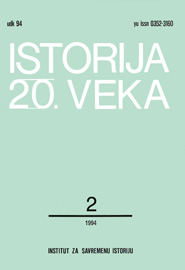JUGOSLOVENSTVO U SVETLU POLEMIKE MEŠTROVIĆ-DUČIĆ 1932. GODINE
THE CRISIS OF THE YUGOSLAV IDEA REFLECTED IN THE MEŠTROVIĆ-DUČIĆ DEBATE IN 1932
Author(s): Smiljana ĐurovićSubject(s): Political history, Recent History (1900 till today), Interwar Period (1920 - 1939), Politics and Identity
Published by: Institut za savremenu istoriju, Beograd
Keywords: Kingdom of Yugoslavia; Yugoslav idea; crisis; struggle for unification; Ivan Meštrović; Jovan Dučić;
Summary/Abstract: Following the solution of the Yugoslav question through the formation of a common state of the Yugoslav peoples in 1918, the fulfillment of a centuries old desire for liberation and unification, the Yugoslav idea continued to exist, being transformed or evolving according to the historic situation of the moment. However, although legally articulated in the country’s name (the Kingdom of Yugoslavia), the Yugoslav idea underwent a crisis at the time of the great social, political and economic hardships of the 30s. This work presents the results of an analytic study of the crisis of the Yugoslav idea viewed through the prism of a debate which took place in 1932 between the renowned sculptor, Ivan Meštrović and »the prince of Serbian poetry«, Jovan Dučić, both of whom took active part in official government affairs of Yugoslavia in the first half of this century. The article follows the evolution of the»Yugoslav« and »Serbian« sentiments of Ivan Meštrović from the time of the struggle for unification, when he identifies the »Serbian«, »Croatian« and the »Yugoslav«, until the 30s, at which time he declared himself to be »ultimately Croatian«. A parallel analytic study is given of the manner in which Dučić identified the »Serbian« with the »Yugoslav«, as well as of the »Yugoslav« inclinations of the editor of »New Europe«magazine, Dr. Milan Ćurčin, and the other members of this magazine's Work Circle. The complexity of the analysis is further proved by a review of discussions pertaining to the question of what is »national« and what modern, or a European trend in the artistic style of Ivan Meštrović,and the history of his most important monuments to liberation and victory in relation to this analysis, such as the »Temple of Vidovdan«, »The Victor«, the »Monument to Liberation« in Dubrovnik, the »Monument to Njegoš«, the »Monument to the Unknown Soldier« on Mt. Avala.
Journal: Istorija 20. veka
- Issue Year: 1994
- Issue No: 2
- Page Range: 61-90
- Page Count: 30
- Language: Serbian

